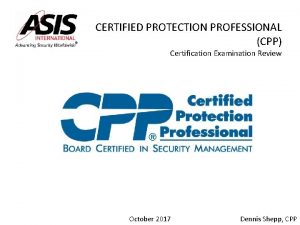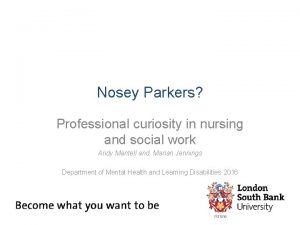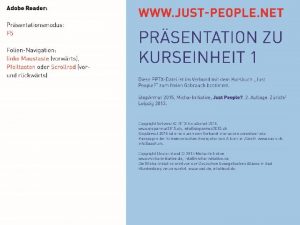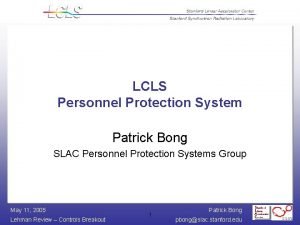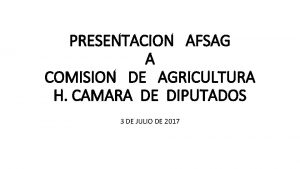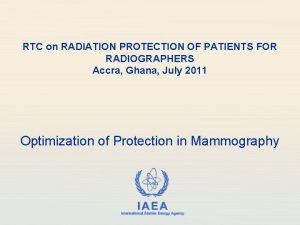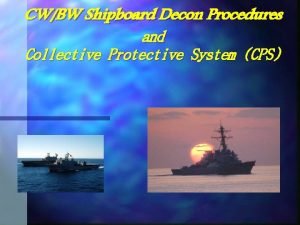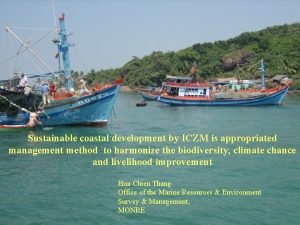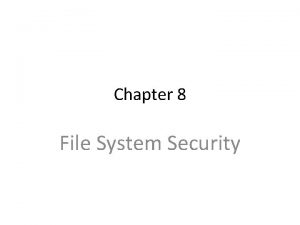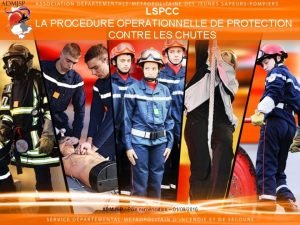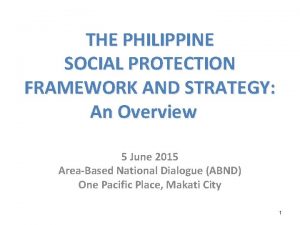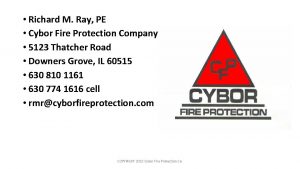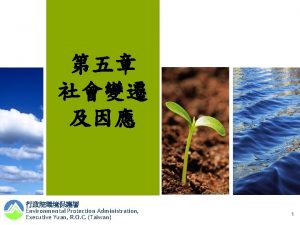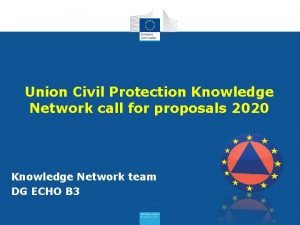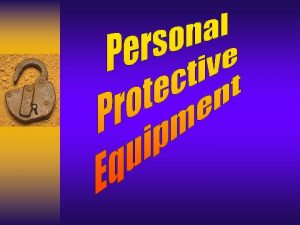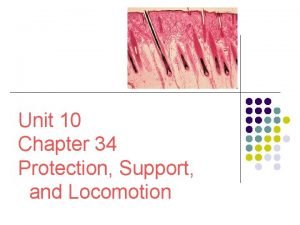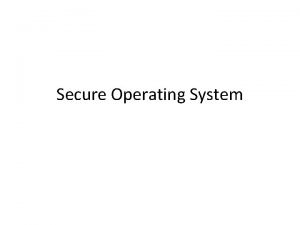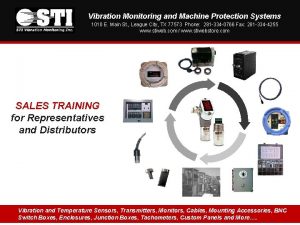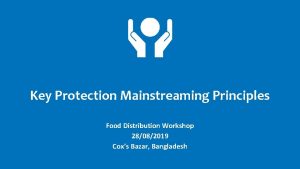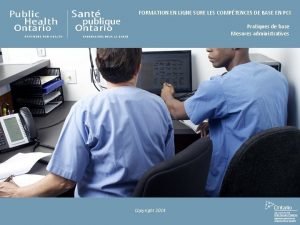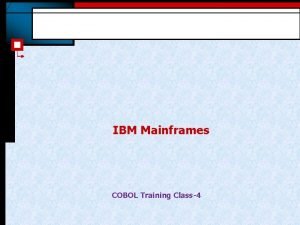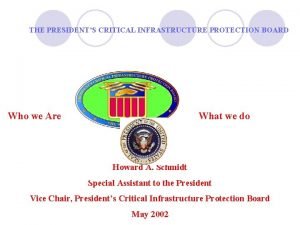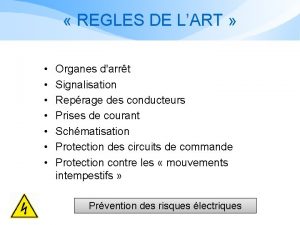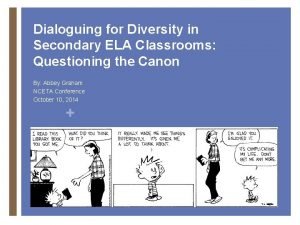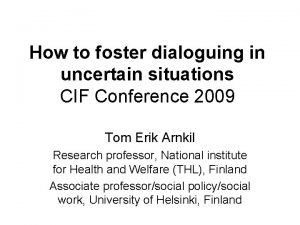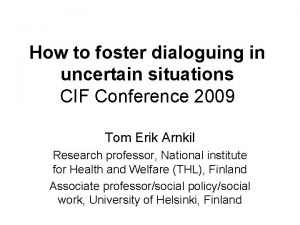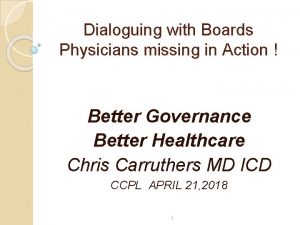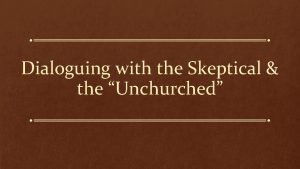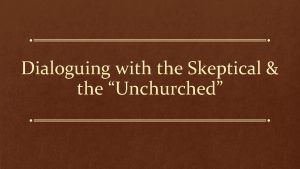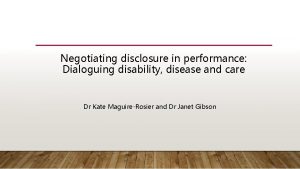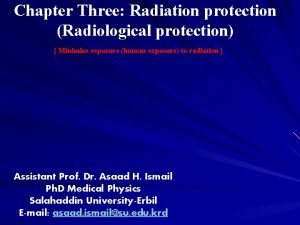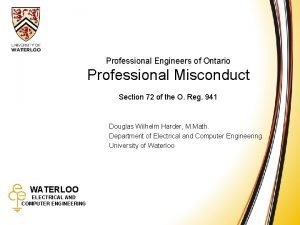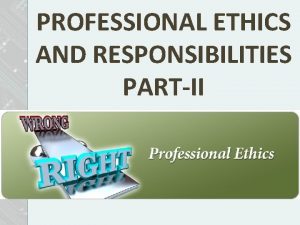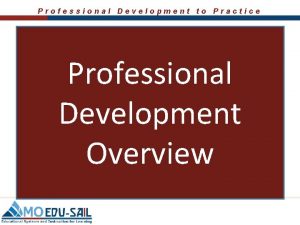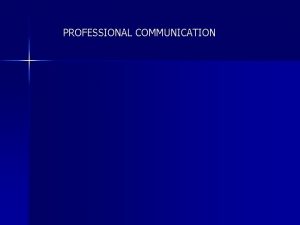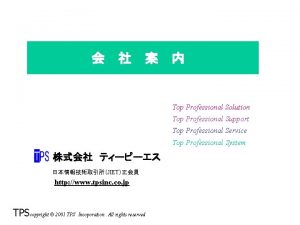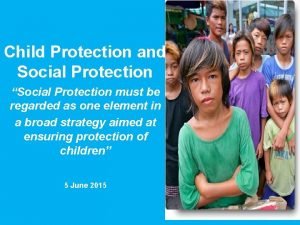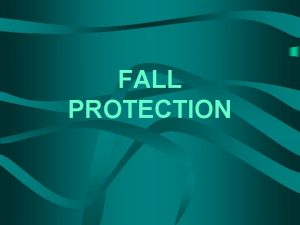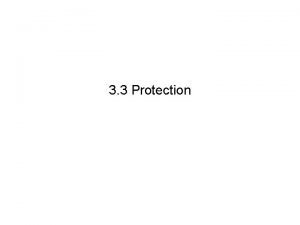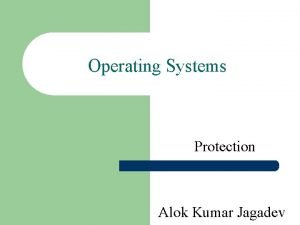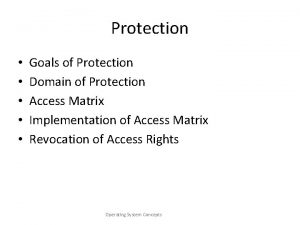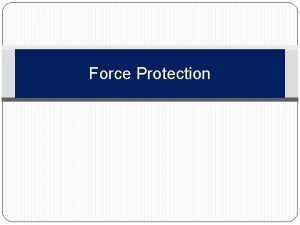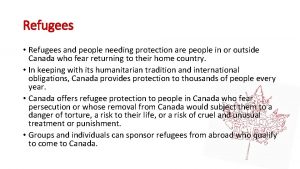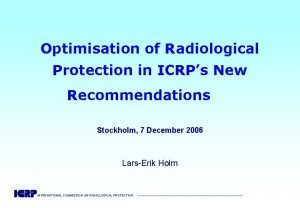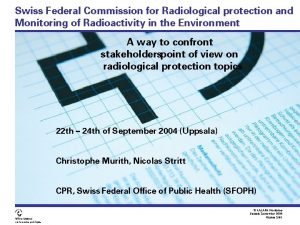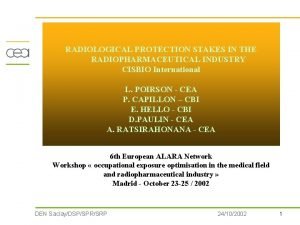Dialoguing with people as a radiological protection professional




































- Slides: 36

Dialoguing with people as a radiological protection professional: lessons from Chernobyl and Fukushima Jacques LOCHARD Vice-Chair of ICRP Director of CEPN FMU International Symposium: Five Years Since the Great East Japan Earthquake, Tsunami and Nuclear Crisis 8 March 2016 Fukushima Medical University, Japan This presentation has neither been approved nor endorsed by ICRP

My personal experience with nuclear post-accident situations � The International Chernobyl Project (1990 -1991) � The CEC/CIS Collaborative Programme (1991 -1995) � The ETHOS Project in Belarus (1996 -2001) � The International CORE Programme in Belarus (2004 -2008) � The ICRP Dialogue Initiative in Fukushima (2011 -2015) 2

An anecdote In the train between Kiev and Minsk in July 1990 3

An anecdote In the train between Kiev and Minsk in July 1990 4

The ETHOS project and CORE program in Belarus (1996 -2008) � Pilot experiments supported by the Belarus authorities in 4 districts of Southern Belarus affected by the Chernobyl accident � Aiming at developing a sustainable improvement of the living conditions of the population in the affected areas � Based on the direct involvement of the local population in its own protection � Working with groups of villagers to addressing their key concerns : protection of children, radiological quality of foodstuffs, management of the domestic radioactive waste, …. 5

The stakeholder involvement process implemented in Belarus � Listening and learning from the villagers about their concerns, difficulties and wishes � Developing a shared evaluation of the local radiological situation between experts and the inhabitants (coexpertise) � Implementing actions for improving the radiological situation and the living conditions of the villagers � Re-establishing links between villagers and the local authorities and professionals 6

Listening about concerns 7

Access to the local expertise 8

Measurement of ambient dose rates 9

10 Ambient dose rates in gardens 10

Measurement of foodstuffs 11

Whole body measurements 12

Dose distribution from caesium intake of children in the Bragin district 20 years after the accident 13

Sharing measurement results 14

Radiological scale for external exposure adopted by villagers 15

Influence of the level of contamination of foodstuffs on the daily intake of a child 16

Implementing protection actions (1) 17

Implementing protection actions (2) 18

Dialogue with local authorities 19

Lessons from Belarus: the human dimension of the post-accident situation � Loss of confidence in authorities and experts � Distancing from the familiar environment � Disintegration of family and social relationships � Strong concerns about the future and particularly about potential health effects for children � General feeling of helplessness and abandonment � Discrimination and exclusion reinforced by the look and attitude of outsiders � Loss of control of daily life and autonomy 20

Lessons from Belarus: the attitudes of the affected population facing contamination � Denial of the risk � Resignation and fatalism � Anxiety and stress � Resilience and willingness to improve the situation 21

Lessons from Belarus: the involvement of the affected people • The Belarus experience has demonstrated that the direct engagement of the population who wish to stay in the affected areas is feasible and also effective to break the vicious circle of loss of control and exclusion • This involvement relies on the dissemination within all segments of the population of a “practical radiation protection culture” based on 2 key pillars: • • A radiation monitoring system giving individuals direct access to the radiological quality of their environment, their diet and finally their exposure • A health surveillance system involving the population and responding to its concerns This is the role of authorities to ensure the implementation of these systems 22

Lessons from Belarus: the role of dialogue • Places of dialogue to listen to the concerns of people and to exchange experiences are essential to initiate the process, which progressively lead to the development of the practical radiological protection culture among the people • In this process the role of experts is to serve local actors and to facilitate the development of their ability to assess and manage their own situation (Self-help protection). • To be effective experts must shift from the explanation of phenomena to the contribution of resolving problems together with the affected people 23

Some lessons I learned in Belarus as a professional • To listen to people living in the affected areas and to rely on their questions and concerns to engage actions with them • To use as much as possible common language while remaining scientifically fair, and to present the facts as they are • To focus on the causes of the exposure and not on the risk • To avoid "paradoxical injunctions" and euphemisms and make use with moderation of prescriptions and prohibitions • To give people the means to make or to be involved in measurements themselves in order to identify and understand the causes of their exposures and the way to control them • To visit people regularly and allow time to people to gaining control of the situation To work with people and not only for them 24

The ICRP Dialogue initiative on the rehabilitation of living conditions after the Fukushima accident A reminder • Timing and topics driven mainly by local interests • 2 days, facilitated by ICRP • 70 to 100 people, including about 30 speakers and panelists • Use of common language • Series of short presentations and structured dialogues • Summarized in a few pages • Some media attention • Shared through the ‘Ethos in Fukushima’ and ICRP websites 25

The ICRP dialogue in Fukushima 2 rd ICRP Dialogue seminar in Date City – February 2012 26

The ICRP dialogue in Fukushima 6 th ICRP Dialogue seminar in Fukushima City – July 2013 27

The ICRP dialogue in Fukushima 7 th ICRP Dialogue seminar in Iwaki– November 2013 28

The dialogue with Suetsugi community 29

Lessons from the Fukushima Dialogue (1) • The Dialogue confirmed the human dimensions that had been found after Chernobyl: • the loss of control over everyday life • the apprehension about the future, particularly that of children • the disintegration of family life and of the social and economic fabric • the threat on the autonomy and dignity of the affected people • Through their testimonies and reflections the Dialogue participants have shed light on this complexity and brought words to better describe it. • They gradually developed a rich narrative about their experiences which helped them to engage into the rehabilitation 30

Lessons from the Fukushima Dialogue (2) • The Dialogue re-emphasized the crucial role of measurements to engage stakeholders and pointed out the need: • to characterize as soon as possible the initial situation • to follow the evolution of the radiological situation and to adapt the protection strategy accordingly • to ensure vigilance in the long term • It confirmed the importance of places of dialogue between experts and the affected population to develop practical radiological protection culture • It also showed that once people have accessed to the practical radiological protection culture they use dose criteria as benchmarks to make their own decisions (self-help protection actions) 31

Lessons from the Fukushima Dialogue (3) • Like in Belarus the Dialogue revealed the difficulty in the recovery phase to establish mechanisms to favour cooperation between all concerned stakeholders: authorities, experts, professionals and the population at the local, regional and national levels • It also confirmed that the protection of children, which is a shared concern of families in Belarus as in Japan is not without drawbacks: restrictions on outside activities, body gain weight, disruption of schooling… • Finally the Dialogue highlighted the key role of the transmission of past experience (Chernobyl) and the solidarity of outsiders 32

Some lessons I learned from Fukushima • The human dimension in Fukushima is very similar to Belarus despite the difference in the cultural and economic development background • Local individuals and communities are able to engage themselves by calling on volunteer experts • The diffusion of good practice between communities in post -accident contexts is a difficult and challenging issue • There is a need to emphasize the ethical basis of the involvement and empowerment of the affected people in the rehabilitation process 33

Concluding remarks about dialogue • Dialogue is a dynamic, multidimensional and context dependent process, aiming to make sense for those involved • Because the accident affects people deeply within themselves and call into question their beliefs and values, it is a form of communication adapted to post-accident situations • Dialogue appeals to the meaning of the situation experienced by the participants. From this point of view it goes beyond risk communication even if this last one is structured and adapted to the situation • In dialogue, the goal is not to be right or to impose a point of view. It is to give participants the opportunity to be transformed into their being, in freedom. • Active listening, sincere humility and mutual respect are therefore necessary. This is something that the radiation protection professionals should integrate into the performance of their expertise. 34

« Whatever men do or know or experience can make sense only to the extent that it can be spoken about. Men in the plural, that is, men in so far as they live and move and act in this world, can experience meaningfulness only because they can talk with and make sense to each other and themselves » . Hannah Arendt The Human Condition 35

www. ICRP. org www. icrp. org
 Tennessee division of radiological health
Tennessee division of radiological health Center for devices and radiological health
Center for devices and radiological health National radiological emergency preparedness conference
National radiological emergency preparedness conference Radiological dispersal device
Radiological dispersal device Cpp
Cpp Professional curiosity in child protection
Professional curiosity in child protection People as media example
People as media example Where is the love black eyed peas lyrics
Where is the love black eyed peas lyrics Transformed people transform people
Transformed people transform people People just people
People just people Patrick bong
Patrick bong Adsag
Adsag Rtc protection film
Rtc protection film Protection
Protection Collective protection system
Collective protection system Coastal protection
Coastal protection File protection and security
File protection and security Rangement lspcc
Rangement lspcc Social protection operational framework philippines
Social protection operational framework philippines 1926 subpart r
1926 subpart r Cybor fire protection
Cybor fire protection Fall protection presentation
Fall protection presentation Environmental protection
Environmental protection Rodent resistant fiber optic cable
Rodent resistant fiber optic cable Union civil protection knowledge network
Union civil protection knowledge network Dead machine protection of generator
Dead machine protection of generator 29 cfr 1910 regarding face head foot and hand protection
29 cfr 1910 regarding face head foot and hand protection Protection support and locomotion answer key
Protection support and locomotion answer key Mandatory protection system
Mandatory protection system Customs and border protection
Customs and border protection Machine protection system
Machine protection system Protection mainstreaming principles
Protection mainstreaming principles Formation en ligne protection respiratoire
Formation en ligne protection respiratoire Edited picture clause in cobol
Edited picture clause in cobol Raid system of data protection
Raid system of data protection Critical infrastructure protection board
Critical infrastructure protection board Les équipements de protection collective
Les équipements de protection collective




